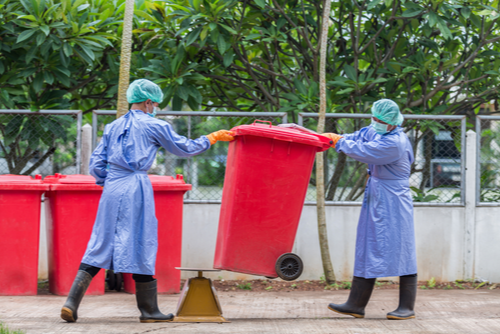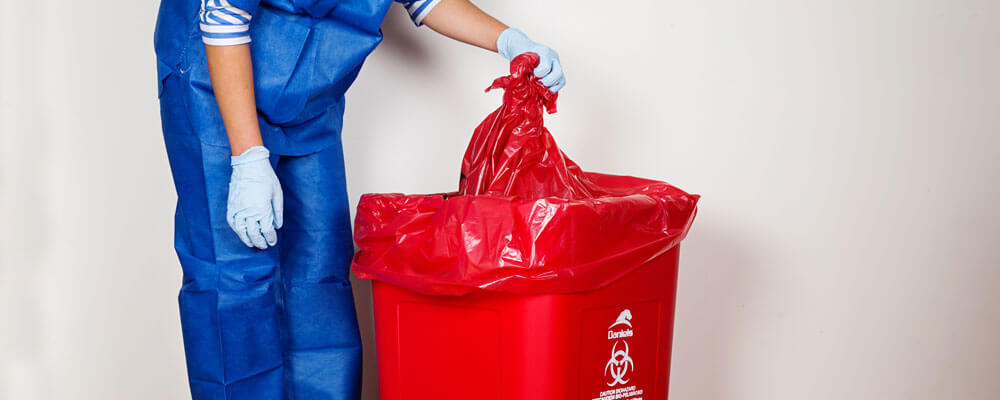Medical Waste Removal Quality: Elevating Safety Requirements in Your Facility
Minimize Prices and Make The Most Of Safety: Effective Medical Garbage Disposal Approaches
Reliable clinical garbage disposal methods are vital for medical care facilities to minimize costs and make the most of security. With the growing concern for ecological sustainability and the raising variety of policies bordering waste monitoring, it is necessary for medical care companies to adopt compliant and reliable methods. By executing proper partition and classification, efficient packaging and labeling, secure transportation and handling, reliable therapy and disposal methods, and conformity with regulative guidelines, health care facilities can make certain the secure and responsible monitoring of medical waste. In this conversation, we will discover each of these techniques thoroughly, supplying insights and useful ideas for medical care experts to optimize their garbage disposal processes.

Appropriate Partition and Categorization
Proper segregation and classification are crucial components of effective medical waste disposal methods, making sure the safety and security of health care workers, the public, and the atmosphere - medical waste removal near me. medical waste disposal services with WasteX. By dividing different sorts of medical waste at the point of generation, healthcare facilities can minimize the danger of cross-contamination and potential damage to environments and individuals
Among the essential variables in appropriate segregation is the recognition and category of clinical waste. This includes classifying waste into various groups, such as transmittable, dangerous, contaminated, or pharmaceutical waste. Each classification calls for certain handling, storage, and disposal techniques to avoid any kind of unfavorable results on human health and the setting.
Moreover, proper segregation likewise consists of using color-coded labels and containers to clearly recognize and separate the various sorts of clinical waste. This helps health care employees and waste management workers to conveniently recognize and manage the waste appropriately. Red containers may be made use of for transmittable waste, while yellow containers might be designated for harmful waste.
In enhancement to partition, proper categorization likewise involves the appropriate product packaging and control of medical waste. This guarantees that waste is safely kept and transported without positioning any risks to individuals or the atmosphere. Utilizing puncture-resistant and watertight containers, along with effectively sealing and labeling them, helps to stop any type of unexpected direct exposure or launch of harmful materials.
Reliable Product Packaging and Identifying
Reliable product packaging and labeling play a critical role in ensuring the reliable and risk-free disposal of medical waste. Proper packaging is vital to avoid leakage, breakage, or splilling throughout transportation and handling. It helps to minimize the risk of contamination and protects medical care employees, waste monitoring personnel, and the environment from potential hazards.
Medical waste ought to be packaged in watertight and tough containers that are immune to penetrate and damage. These containers ought to be properly secured to stop any type of leakage. In addition, the packaging should have the ability to stand up to the conditions of transport, including temperature level variations and misuse.
Classifying is similarly important as it provides essential details regarding the materials of the waste and any type of potential threats related to it. The labels need to include the name of the healthcare facility, the sort of waste, and any type of unique handling directions. Standardized and clear labeling ensures that waste administration employees can conveniently recognize and deal with the waste suitably.
Effective product packaging and labeling also help in the proper partition and categorization of clinical waste. Clear labeling permits simple recognition of different waste streams, such as transmittable waste, sharps, or pharmaceutical waste. This helps in enhancing the disposal procedure and guaranteeing that the waste is dealt with or thrown away according to regulative standards.
Safe Transportation and Handling
Ensuring the risk-free transport and handling of clinical waste is of utmost significance in order to protect against any prospective health and wellness and ecological risks. Medical waste, such as sharps, polluted products, and pharmaceutical waste, have to be properly packaged and taken care of to minimize the danger of direct exposure to unsafe substances and microorganisms.
Carrying clinical waste requires compliance with rigorous laws and standards set by environmental companies and local authorities. These policies aim to secure the health and wellness of employees associated with waste monitoring and protect against the launch of harmful products right into the atmosphere.
To make certain secure transport, clinical waste must be put in leak-proof and puncture-resistant containers that are appropriately sealed and labeled. These containers ought to be secured in such a way that prevents spills or damage throughout transportation (medical waste removal service). Additionally, it is essential to use specialized lorries outfitted with proper security features to transport clinical waste. These vehicles ought to have sufficient air flow and be developed to avoid leakage or contamination.
Dealing with have a peek here medical waste also requires appropriate training and adherence to safety and security protocols. Workers associated with the handling of clinical waste need to wear suitable individual safety tools (PPE) such as gloves, masks, and gowns to lessen the threat of direct exposure. They should likewise adhere to rigorous hygiene practices to stop the spread of infections and make sure the secure disposal of waste.
Reliable Therapy and Disposal Approaches
Implementing proper treatment and disposal techniques is critical in taking care of clinical waste properly and minimizing potential wellness and ecological risks. Clinical waste, that includes sharps, transmittable products, chemicals, and pharmaceuticals, can position considerable risks if not handled and thrown away properly. There are numerous therapy and disposal techniques offered that stick to governing standards and advertise safe practices.
One usual method is incineration, which includes shedding the waste at heats. Incineration works in damaging virus and reducing the volume of waste, yet it can launch harmful pollutants into the air otherwise properly controlled. It is vital to make use of contemporary incinerators geared up with emission control technologies.
An additional approach is autoclaving, which makes use of heavy steam and pressure to sanitize the waste. Autoclaving is effective in eliminating virus and minimizing the volume of waste, but it needs cautious surveillance and upkeep to make certain appropriate functioning. The sterilized waste can after that be securely gotten rid of in a landfill.
Chemical therapy is an additional choice, which involves making use of anti-bacterials or other chemicals to counteract microorganisms. This method is generally utilized for liquid waste, such as lab specimens. It is crucial to use proper chemicals and follow appropriate treatments to ensure effective treatment and protect against environmental contamination.

Compliance With Regulatory Guidelines
Abiding by governing guidelines is essential in making sure proper compliance with clinical waste disposal methods. These standards are placed in place to secure public wellness, avoid ecological contamination, and keep workplace security. Conformity with regulatory guidelines is vital for medical care facilities, as non-compliance can lead to charges, penalties, and reputational damages.
Regulatory guidelines outline the proper handling, storage, transportation, and disposal of medical waste. These guidelines also address the partition of various waste streams, such as sharps, transmittable waste, and pharmaceutical waste.
To keep conformity, health care facilities should establish comprehensive waste management programs that consist of team training, routine audits, and continuous tracking. It is vital to keep up-to-date with any type of adjustments or updates to regulatory standards, as techniques may develop in time. By remaining educated and carrying out appropriate protocols, health care facilities can reduce the possibility for regulative infractions and protect the health and wellness of their staff, patients, and the bordering neighborhood.
Final Thought
Finally, applying efficient medical garbage disposal techniques is essential for optimizing and reducing prices safety and security. Proper partition and More Help categorization, reliable packaging and labeling, secure transportation and handling, and efficient treatment and disposal techniques are necessary steps to guarantee compliance with regulative standards. medical waste removal. By sticking to these strategies, health care centers can protect the atmosphere and public wellness while likewise lowering economic concerns linked with medical waste administration
By applying proper segregation and classification, reliable Click Here packaging and labeling, risk-free transport and handling, reliable treatment and disposal approaches, and compliance with regulatory guidelines, health care centers can ensure the safe and accountable monitoring of clinical waste. Red containers may be made use of for transmittable waste, while yellow containers might be designated for dangerous waste.
Standard and clear labeling makes certain that waste monitoring personnel can easily identify and deal with the waste properly. (medical waste disposal services with WasteX)
Clear labeling allows for easy recognition of various waste streams, such as infectious waste, sharps, or pharmaceutical waste. These guidelines additionally resolve the partition of various waste streams, such as sharps, contagious waste, and pharmaceutical waste.